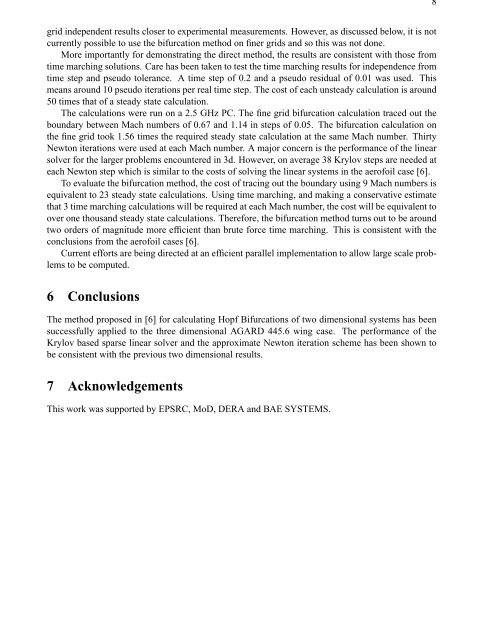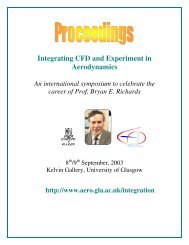IFASD Paper 2003 - CFD4Aircraft
IFASD Paper 2003 - CFD4Aircraft
IFASD Paper 2003 - CFD4Aircraft
Create successful ePaper yourself
Turn your PDF publications into a flip-book with our unique Google optimized e-Paper software.
8<br />
grid independent results closer to experimental measurements. However, as discussed below, it is not<br />
currently possible to use the bifurcation method on finer grids and so this was not done.<br />
More importantly for demonstrating the direct method, the results are consistent with those from<br />
time marching solutions. Care has been taken to test the time marching results for independence from<br />
time step and pseudo tolerance. A time step of 0.2 and a pseudo residual of 0.01 was used. This<br />
means around 10 pseudo iterations per real time step. The cost of each unsteady calculation is around<br />
50 times that of a steady state calculation.<br />
The calculations were run on a 2.5 GHz PC. The fine grid bifurcation calculation traced out the<br />
boundary between Mach numbers of 0.67 and 1.14 in steps of 0.05. The bifurcation calculation on<br />
the fine grid took 1.56 times the required steady state calculation at the same Mach number. Thirty<br />
Newton iterations were used at each Mach number. A major concern is the performance of the linear<br />
solver for the larger problems encountered in 3d. However, on average 38 Krylov steps are needed at<br />
each Newton step which is similar to the costs of solving the linear systems in the aerofoil case [6].<br />
To evaluate the bifurcation method, the cost of tracing out the boundary using 9 Mach numbers is<br />
equivalent to 23 steady state calculations. Using time marching, and making a conservative estimate<br />
that 3 time marching calculations will be required at each Mach number, the cost will be equivalent to<br />
over one thousand steady state calculations. Therefore, the bifurcation method turns out to be around<br />
two orders of magnitude more efficient than brute force time marching. This is consistent with the<br />
conclusions from the aerofoil cases [6].<br />
Current efforts are being directed at an efficient parallel implementation to allow large scale problems<br />
to be computed.<br />
6 Conclusions<br />
The method proposed in [6] for calculating Hopf Bifurcations of two dimensional systems has been<br />
successfully applied to the three dimensional AGARD 445.6 wing case. The performance of the<br />
Krylov based sparse linear solver and the approximate Newton iteration scheme has been shown to<br />
be consistent with the previous two dimensional results.<br />
7 Acknowledgements<br />
This work was supported by EPSRC, MoD, DERA and BAE SYSTEMS.

















